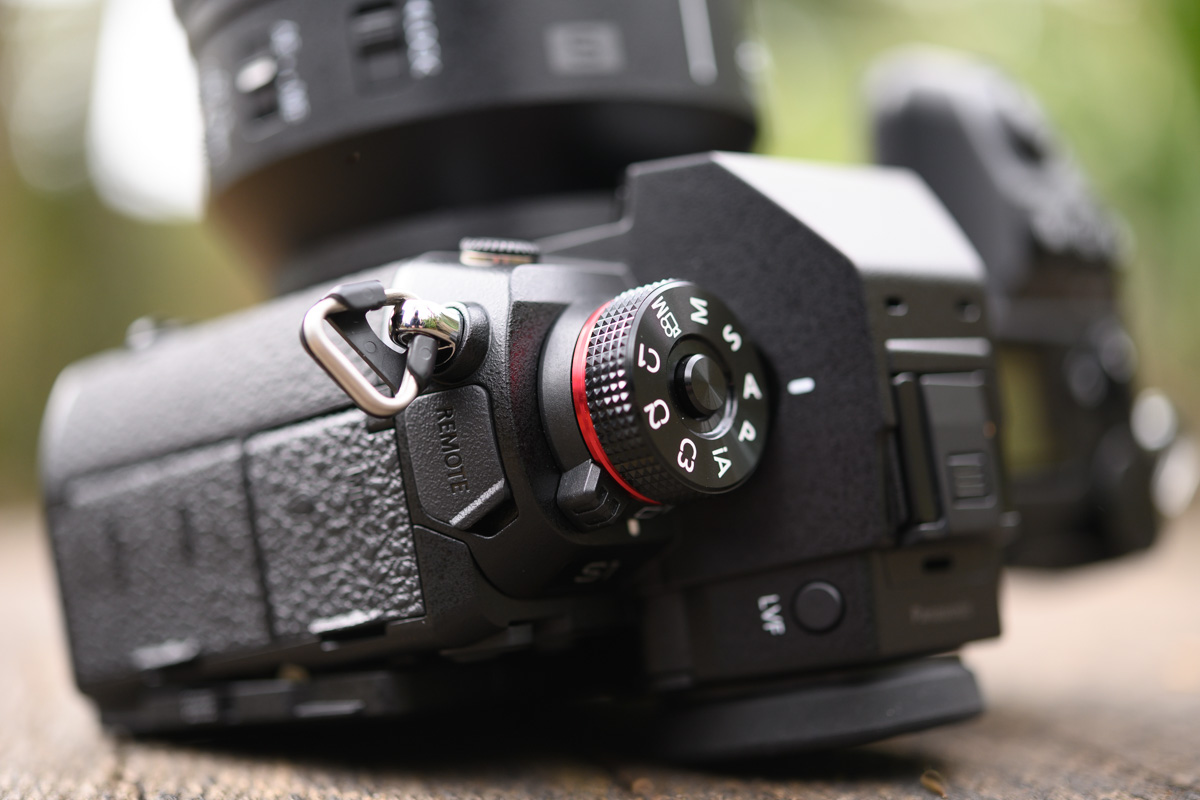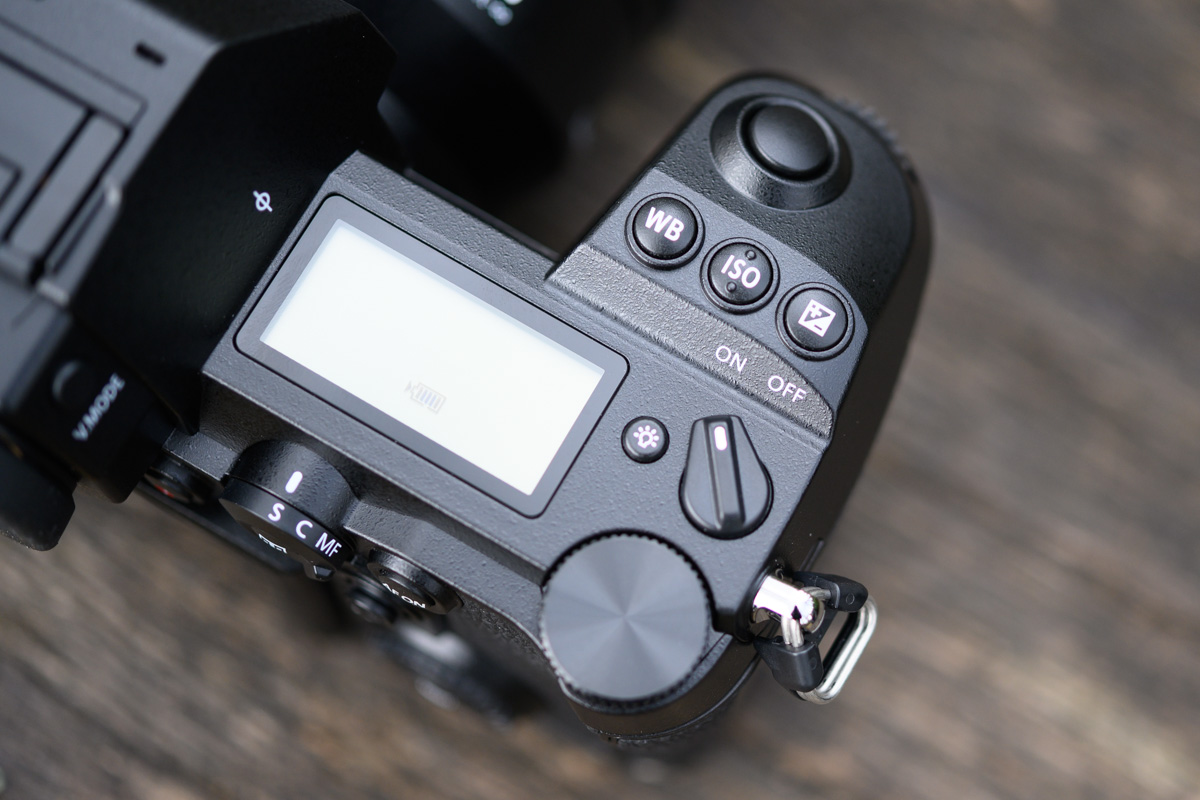Why you can trust TechRadar
Build and handling
- Magnesium alloy die-cast front and rear panels
- Dust-, splash- and freeze-proof
- Shutter rated to 400,000 actuations
In some respects the Panasonic Lumix S1 looks much like Panasonic's G9 mirrorless camera, with its blend of angular and rounded details and familiar touches like the red ring under the mode dial. There's a lot that's new, but there's plenty that's comfortingly familiar too.
The top plate has a mode dial perched on top of the drive mode collar, and this has a button in its center that needs to be held down in order for the mode dial to rotate. Which locking system you prefer here – either holding it down whenever you want to turn the dial, as here, or pressing this button down once to free it and again to lock it, as on other cameras – is a personal thing, but this system is arguably more secure.
The fact that the dial has the drive mode collar at its base means it stands proud enough from the top plate for comfortable operation, although the way it clicks between positions isn't quite as nice as the more fluid movement from the dials on models like the Nikon Z6, Pentax K-1 Mark II and others.
The other side of the top plate sports white balance, ISO and exposure compensation buttons, together with a small lamp that illuminates the status LCD that dominates this section. In use, the lamp lights up the screen evenly, and the screen itself packs in a lot of detail.
A large rear command dial sits in the corner here, and this is matched by a further dial at the top of the grip. Both dials have fairly coarse movements, which we personally quite like, and each appears to respond as sensitively to movements regardless of how quickly you rotate them, which is useful, as you know you can quickly zip through apertures, shutter speeds, ISO or something else at speed when you need to.
The white balance and ISO buttons press positively, and while the standard mode of operation is to hold these down while turning the rear command dial, you can also just press these repeatedly to cycle though the different options.




On the back of the S1, Panasonic has clearly started from scratch rather than chosen to adopt the existing setup of physical controls common to its top-end G-series models. While much can still be customized here, the focus is clearly on placing specific controls in specific places, rather than flooding the back plate with Fn buttons that you then customize yourself.
Sign up for breaking news, reviews, opinion, top tech deals, and more.
There's a new locking lever conveniently out of the way on the left-hand side that prevents settings from being changed accidentally (and you can select which controls to lock), together with dedicated controls for the Q menu, movie recording, focus pattern selection and AF-On among other things. A handful of these can also be illuminated, which is useful when working in darker conditions.
There's also a joystick-like focus lever that falls very conveniently to the left of where left of where the thumb naturally falls, and this responds well to movements in all directions, even diagonally. When it's down, the focusing point is moved quickly across the frame, although you can also use the touchscreen if you need to quickly focus on a specific area.
Panasonic says the S1 is protected against dust and splashes, and that it can be used in temperatures as low as -10ºC. The front and rear panels are built from magnesium alloy, and there's plenty of rubber used around the grip, front plate, side doors and on the back, and the doors to the various ports close firmly. Inside, the mechanical shutter is rated to 400,000 actuations, which is a very respectable figure when you consider that's exactly what Nikon and Canon claim for their respective pricier flagship DSLRs, the D5 and EOS-1D X Mark II.
This is a large and hefty camera, and the grip itself is large, but as the body is relatively thick the grip doesn't stand out from the body by even an inch, which can leave the tips of your fingers pressed against the front plate. Overall build quality, however, feels superb. The weight of the camera potentially helps to give you this impression to begin with, but as you operate the various controls and access the various compartments you can see that everything's been put together very well.




Possibly in order to make the Panasonic S1 as protected as possible, however, a few things are difficult to get used to, even after extended use. One of these is the position of the power control, halfway between the rear of the camera where the thumb rests and the shutter release button where your index finger will naturally fall. On such a large body its position isn't really convenient for either thumb or finger without you either repositioning your hand slightly or stretching it awkwardly. A G9-style control around the shutter release button would be far easier to get on board with.
The menu pad dial also feels somewhat unyielding when its up, down, left or right positions are pressed, an experience that's contrasted by a rotation of this dial when scrolling through images or menus, which works like a dream.
The memory card slot is also a little fiddly to access; rather than just pulling the door back and it springing open, you have to pull the switch down before pulling the cover back, each in a different direction. It's possible these small design issues are necessary in order to provide the most complete weather protection possible, but given how frequently these features are used it would be nice if they were a little more user-friendly.
Autofocus
- Light Speed AF system with 225 points
- Depth From Defocus (DFD) technology
- EV -6 - 18 working range
On the surface, the focusing system in the Panasonic Lumix S1 appears to be similar to that which Panasonic has used inside its most recent G-series cameras: a 225-point contrast-detect system with Depth From Defocus (DFD) technology. At a time when we're seeing hybrid phase- and contrast-detect AF systems as standard on mirrorless cameras, some may be surprised to see Panasonic sticking with a more vanilla contrast-detect AF setup.
Nevertheless, the company claims that the system, together with the power of the Venus engine, imaging sensor and the compatible lenses, communicate at a rate of up to 480fps, and that this enables focusing in as little as 0.08 seconds. Panasonic also reckons the S1 can continue to focus down to -6EV, which is the same as Canon claims for its EOS R. Theoretically, this should make the camera a little better when shooting in darker conditions than many of its peers.
We've only had the opportunity to test the system with the 24-105mm lens, and results are mixed. For a contrast-detect AF system it does well when faced with well-lit scenes and subjects, and appears to be on a par with the similar systems seen inside Panasonic's G-series cameras. As light levels fall, the camera can't quite bring subjects to focus with the same speed as some others, even if it can detect them. It can occasionally prove quite leisurely in shifting focus as you switch between close-up subjects and those at a distance too.
To its credit, the AF system does attempt to bring subjects to rough focus before you've pressed the shutter release button, and you can also set it to start focusing as soon as you lift your eye to the viewfinder, and you can also opt to capture the image as soon as the AF has found focus upon a half-press of the shutter release button, rather than upon a full press, which speeds things up a little.
Panasonic is also jumping on the AI bandwagon by claiming that Advanced Artificial Intelligence Technology can detect and track humans, cats, dogs and birds, and continue to follow them even when they have their back turned to the camera. This is something we found worked well with the Panasonic S1R when we tested it at the model's launch, and this is bolstered by face, eye, and pupil detection. The feature appears to work just as well here, quickly placing a box around the relevant subject as it detects it and sticking to it well as it moves.
You can easily flick between single, continuous and manual focus via a dial on the back plate, while the button in the center brings up 10 focusing patterns, from an auto mode with face, eye, body and animal detection enabled through to pinpoint and custom options. The fact that this is located with the AF joystick and the customizable AF On buttons places a lot of focusing power right where it's most convenient.
When set to track moving subjects, the camera generally does well to keep a lock on them as they move around the scene, only occasionally getting distracted by something else. On its own this only tracks where subjects are, rather than continuously bringing them to focus, and so continuous focus also needs to be enabled if that's what you want to do. This can work well, but the disadvantage of a contrast-detect AF setup is clear here, with a little too much hesitation and back-and-forth movements.
You can also focus by simply tapping the desired point on the touchscreen, and you can use the Touch Pad AF feature to set the focus point via the display when using the viewfinder. The excellent sensitivity of the LCD screen makes this effortless, although this is something of a double-egded benefit, as it can be far too easy to accidentally brush the side of corner of the screen, which has the effect of sending the focusing point there.
At a time when we're seeing hybrid phase- and contrast-detect AF systems as standard on mirrorless cameras, some may be surprised to see Panasonic sticking with a more vanilla contrast-detect AF setup
Dig deeper, and there's a whole lot more that's designed to make both autofocusing and manual focusing easier. When using autofocus you can change the size of the focusing point and enlarge the focused area by up to 10 times to check accuracy, and you can also override the autofocus with manual focus for fine-tuning.
Focus peaking is also on hand when you're focusing manually, as are two options that enlarge the area you're focusing on, one being a 6x picture-in-picture mode and the other zooming fully into the frame by a factor of 20x. It's also possible to switch between linear and non-linear response from the focusing ring when manually focusing the lens, which is great, as many people aren't too keen on non-linear response when focusing a lens. This works as well as you'd expect in practice, too; you wouldn't think the focusing group wasn't mechanically coupled if you didn't know.
Overall, there's plenty to customize here, with many different options to set the focusing system to your preferred way of working. Panasonic has made excellent use of both physical controls and virtual ones through the touchscreen, and focusing performance is generally sound for static subjects. It's only really when set to continuously focus on moving subjects, and when shooting in low light, that you may see the S1's shortcomings.
Current page: Build, handling and AF
Prev Page Introduction and key features Next Page Performance and image quality